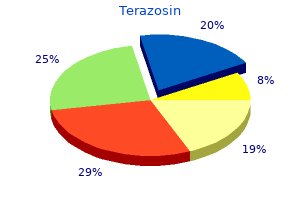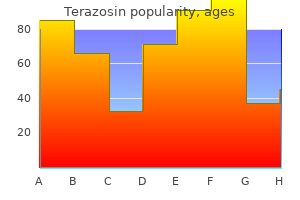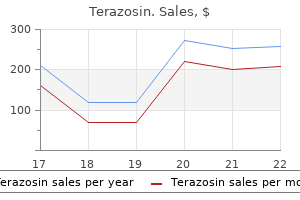

"Order 2mg terazosin fast delivery, blood pressure chart guide".
B. Esiel, MD
Co-Director, Tulane University School of Medicine
A 65-year-old man blood pressure ranges for males discount terazosin 2 mg otc, on returning home from a party blood pressure chart to age purchase terazosin 2mg overnight delivery, found that he could not climb the stairs blood pressure medication weight loss purchase terazosin 1 mg otc. He had consumed a large amount of whiskey and seemed to have lost control of his legs heart attack young adults buy terazosin 1mg with visa. He sat down on a chair in the hallway and was soon in a deep, stuporous sleep, with his right arm suspended over the back of the chair. The next morning, he awoke with a severe headache and loss of the use of his right arm and hand. During examination in the emergency department, it was found that the patient had severe paralysis involving branches of the medial cord of the brachial plexus and the radial nerve. The diagnosis was neuropraxia, which occurred as the result of the pressure of the back of the chair on the involved nerves. A well-known politician was attending a rally when a youth suddenly stepped forward and shot him in the back. During examination in the emergency department, it was found that the bullet had entered the back obliquely and was lodged in the vertebral canal at the level of the eighth thoracic vertebra. The patient could not feel anything below this level and was paralyzed from the waist downward. An 18-year-old woman visited her physician because she had burns, which she had not felt, on the tips of the fingers of the right hand. On physical examination, severe scarring of the fingers of the right hand was noted. Testing the sensory modalities of the skin of the entire patient showed total loss of pain and temperature sensation of the distal part of the right upper limb. Definite muscular weakness was demonstrated in the small muscles of the right hand, and a small amount of weakness also was found in the muscles of the left hand. A 35-year-old man, while walking past some workmen who were digging a hole in the road, suddenly became aware of a foreign body in his left eye. A 60-year-old man visited his physician because for the past 3 months he had been experiencing an agonizing stabbing pain over the middle part of the right side of his face. Using your knowledge of neuroanatomy, explain why hairs are so sensitive to touch. On physical examination, many signs of the syphilitic disease were present,including a total lack of deep sensation to pain. Using your knowledge of neuroanatomy, explain how deep pain sensation is normally experienced. While carrying out a physical examination of a patient, the physician asked the patient to cross his knees and relax his leg muscles. The left ligamentum patellae was then struck smartly with a reflex hammer, which immediately produced an involuntary partial extension of the left knee joint (the knee-jerk test was positive). How does the central nervous system receive nervous information from the quadriceps femoris muscle in order that it may respond reflexly by extending the knee A 55-year-old man suffering from syphilis of the spinal cord presented characteristic symptoms and signs of tabes dorsalis. He had experienced severe stabbing pains in the abdomen and legs for the last 6 months. When asked to walk, the patient was seen to do so with a broad base, slapping the feet on the ground. Using your knowledge of neuroanatomy, explain how a normal individual is able to perceive the position of the extremities and detect vibrations. Using your knowledge of pharmacology,name two drugs that act as competitive blocking agents on skeletal neuromuscular junctions. Name a drug that will bring about flaccid paralysis of skeletal muscle by causing depolarization of the postsynaptic membrane. In cases of severe food poisoning,the organism Clostridium botulinum may be found to be responsible. During a ward round, an orthopedic surgeon stated that the degree of muscular atrophy that occurs in a limb immobilized in a cast is totally different from the degree of muscular atrophy that follows section of the motor nerve supply to muscles.

Implementation of these "personalized" medicines is very complex from a drug development as well as from a regulatory perspective and pharmaceutical companies will have to factor in development of diagnostics for identified predictive biomarkers as an investment in this approach prehypertension in spanish purchase 2 mg terazosin free shipping. Targeted therapies are per definition likely to be more effective at earlier stage where the driver for the tumour growth is the particular target blood pressure medication valsartan terazosin 2mg cheap. Gleevec serves a defined but small population arrhythmia jokes purchase terazosin 1 mg visa, and this is the case with targeted therapies blood pressure is highest in the generic terazosin 1mg amex. Thus, the trend in targeted therapy is towards many niched treatments rather than sweeping standard therapies as we have had with chemotherapy. Other drugs work in a similar way, including erlotinib (Tarceva) for a form of lung cancer, bevacizumab (Avastin) for breast, colorectal and other cancers, and sunitinib (Sutent) for renal cell carcinoma and gastrointestinal sarcoma. Most tumours grow by multiple mechanisms so that preventing one such mechanism might not be enough and since cancer cells mutate rapidly, tumours can evolve resistance, sometimes very quickly, and neighboring cells in a tumour might be different and not susceptible to the same drug. The first molecular target for targeted cancer therapy was the cellular receptor for the female sex hormone estrogen, which many breast cancers require for growth. Blocking the activity of aromatase lowers estrogen levels and inhibits the growth of cancers that need estrogen to grow. Aromatase inhibitors are used mostly in women who have reached menopause because the ovaries of premenopausal women can produce enough aromatase to override the inhibition. The general idea is to develop new therapies that direct our immune system response against cancer cells, which results in their destruction through a natural and highly effective system. Through its mechanism of action, it frees one of the natural restrictions put on the immune system to allow for targeting of malignant melanoma cells to great success. The next generation of unconjugated antibody therapies will undoubtedly yield many effective new treatments for cancer over the next decade. Once activated, these nuclear proteins act in concert with retinoic acid receptors to regulate the expression of genes that control cell growth, differentiation, survival, and death. Other targeted therapies block the growth of blood vessels to tumours (angiogenesis). To grow beyond a certain size, tumours must obtain a blood supply to get the oxygen and nutrients needed for continued growth. When rituximab binds to these cells, it triggers an immune response that results in their destruction. Some of the antibodies in the mixture are linked to a radioactive substance called iodine-131. In most cases, another targeted therapy that could overcome this resistance is not available. It is for this reason that targeted therapies may work best in combination, either with other targeted therapies or with more traditional therapies. In mice, effective immunity is often elicited and a successful pre-immunization against almost any kind of tumour seems to be feasible as a preventative measure. However, therapeutic immunization in the setting of established, chronic disease such as breast cancer, colorectal cancer and the like has been much less successful. Transfer of experimental results with preventative vaccines to the clinical setting and the prospect of curing cancer with therapeutic vaccines are in principle seen as feasible goals. There are many clinical trials but the results achieved so far, however, have been poor; partial responses are rare and complete responses extremely rare. Only in a few patients has the progression of previously growing tumours been halted and prolonged survivals observed. In the body, the cells help other immune system cells to attack the prostate cancer. Researchers are developing treatment vaccines against many types of cancer and testing them in clinical trials. Cancer treatment vaccines are designed to work by activating B cells and killer T cells and directing them to recognize and act against specific types of cancer. They do this by introducing one or more molecules known as antigens into the body, usually by injection. An antigen can be a protein or another type of molecule found on the surface of or inside a cell.

The sympathetic nerves are vasoconstrictor in action to the renal arteries within the kidney blood pressure 200110 purchase terazosin 2mg without prescription. Here hypertension guidelines discount terazosin 1 mg without prescription, they synapse with postganglionic neurons blood pressure and anxiety order terazosin 2mg with mastercard, whose fibers are distributed to the kidney along the branches of the renal artery arteria profunda brachii buy terazosin 1 mg fast delivery. Involuntary Internal Sphincter of the Anal Canal the circular smooth muscle coat is thickened at the upper end of the anal canal to form the involuntary internal sphincter. The sphincter is innervated by postganglionic sympathetic fibers from the hypogastric plexuses. Each hypogastric plexus receives sympathetic fibers from the aortic plexus and from the lumbar and pelvic parts of the sympathetic trunks. Urinary Bladder the muscular coat of the bladder is composed of smooth muscle, which at the bladder neck is thickened to form the sphincter vesicae. The sympathetic postganglionic fibers originate in the first and second lumbar ganglia of the sympathetic trunk and travel to the hypogastric plexuses. The parasympathetic preganglionic fibers arise as the pelvic splanchnic nerves from the second, third, and fourth sacral nerves; they pass through the hypogastric plexuses to reach the bladder wall, where they synapse with postganglionic neurons. The sympathetic nerves to the detrusor muscle have little or no action on the smooth muscle of the bladder wall and are distributed mainly to the blood vessels. The Medulla of Suprarenal Gland Preganglionic sympathetic fibers descend to the gland in the greater splanchnic nerve, a branch of the thoracic part of the sympathetic trunk. The nerve fibers terminate on the secretory cells of the medulla, which are comparable to postganglionic neurons. Acetylcholine is the transmitter substance between the nerve endings and the secretory cells,as at any other preganglionic endings. The sympathetic nerves stimulate the secretory cells of the Some Important Autonomic Innervations 413 Sympathetic trunk Involuntary internal sphincter of anal canal Anus T11-L2 Through hypogastric plexuses Urinary bladder S2, 3, 4 Pelvic splanchnic nerve Through hypogastric plexuses Hypogastric plexuses Sphincter vesicae Figure 14-14 Autonomic innervation of the sphincters of the anal canal and urinary bladder. However, in the male, the sympathetic innervation of the sphincter causes active contraction of the bladder neck during ejaculation (brought about by sympathetic action), thus preventing seminal fluid from entering the bladder. The parasympathetic nerves stimulate the contraction of the smooth muscle of the bladder wall and, in some way, inhibit the contraction of the sphincter vesicae. Ejaculation During the increasing sexual excitement that occurs during sex play, the external urinary meatus of the glans penis becomes moist as a result of the secretions of the bulbourethral glands. Friction on the glans penis,reinforced by other afferent nervous impulses, results in a discharge along the sympathetic nerve fibers to the smooth muscle of the duct of the epididymis and the vas deferens on each side,the seminal vesicles,and the prostate. The smooth muscle contracts, and the spermatozoa, together with the secretions of the seminal vesicles and prostate, are discharged into the prostatic urethra. The fluid now joins the secretions of the bulbourethral glands and penile urethral glands and is then ejected from the penile urethra as a result of the rhythmic contractions of the bulbospongiosus muscles, which compress the urethra. Meanwhile, the sphincter of the bladder contracts and prevents a reflux of the spermatozoa into the bladder. The spermatozoa and the secretions of the several accessory glands constitute the seminal fluid, or semen. At the climax of male sexual excitement, a mass discharge of nervous impulses takes place in the central nervous system. The nervous impulses that pass to the genital organs are thought to leave the cord Erection of the Penis and Clitoris In erection, the genital erectile tissue becomes engorged with blood. The initial vascular engorgement is controlled by the parasympathetic part of the autonomic nervous system. The parasympathetic preganglionic fibers originate in the gray matter of the second, third, and fourth sacral segments of the spinal cord. The fibers enter the hypogastric plexuses and synapse on the postganglionic neurons. The postganglionic fibers join the internal pudendal arteries and are distributed along their branches, which enter the erectile tissue. The parasympathetic nerves cause vasodilatation of the arteries and greatly increase the blood flow to the erectile tissue. Many of these fibers synapse with postganglionic neurons in the first and second lumbar ganglia. Other fibers may synapse in ganglia in the lower lumbar or pelvic parts of the sympathetic trunks.
At rest arrhythmia reentry cheap terazosin 5mg free shipping, the eye looks laterally (external strabismus) blood pressure and age generic terazosin 1 mg without a prescription, owing to the activity of the lateral rectus arrhythmia treatment medications order 1mg terazosin fast delivery, and downward pulse pressure 2012 purchase 5 mg terazosin free shipping, owing to the activity of the superior oblique. There is drooping of the upper eyelid (ptosis) due to paralysis of the levator palpebrae superioris. The pupil is widely dilated and nonreactive to light, owing to paralysis of the sphincter pupillae and unopposed action of the dilator (supplied by the sympathetic). Incomplete lesions of the oculomotor nerve are common and may spare the extraocular muscles or the intraocular muscles. The condition in which the innervation of the extraocular muscles is spared with selective loss of the autonomic innervation of the sphincter pupillae and ciliary muscle is called internal ophthalmoplegia. The condition in which the sphincter pupillae and the ciliary muscle are spared with paralysis of the extraocular muscles is called external ophthalmoplegia. The possible explanation for the involvement of the autonomic nerves and the sparing of the remaining fibers is that the parasympathetic autonomic fibers are superficially placed within the oculomotor nerve and are likely to be first affected by compression. For example, in cases of diabetes with impaired nerve conduction (diabetic neuropathy), the autonomic fibers are unaffected, whereas the nerves to the extraocular muscles are paralyzed. The conditions most commonly affecting the oculomotor nerve are diabetes, aneurysm, tumor, trauma, inflammation, and vascular disease. See lesions of the oculomotor nerve in the midbrain (Benedikt syndrome) on page 220. The sensory root passes to the trigeminal ganglion, from which emerge the ophthalmic (V1), maxillary (V2), and mandibular (V3) divisions. The sensory function may be tested by using cotton and a pin over each area of the face supplied by the divisions of the trigeminal nerve. Note that there is very little overlap of the dermatomes and that the skin covering the angle of the jaw is innervated by branches from the cervical plexus (C2 and C3). In lesions of the ophthalmic division, the cornea and conjunctiva will be insensitive to touch. The motor function may be tested by asking the patient to clench his or her teeth. The masseter and the temporalis muscles can be palpated and felt to harden as they contract. Trigeminal Neuralgia In trigenimal neuralgia,the severe,stabbing pain over the face is of unknown cause and involves the pain fibers of the trigeminal nerve. Pain is felt most commonly over the skin areas innervated by the mandibular and maxillary divisions of the trigeminal nerve; only rarely is pain felt in the area supplied by the ophthalmic division. Trochlear Nerve the trochlear nerve supplies the superior oblique muscle, which rotates the eye downward and laterally. In lesions of the trochlear nerve, the patient complains of double vision on looking straight downward, because the images of the two eyes are tilted relative to each other. This is because the superior oblique is paralyzed, and the eye turns medially as well as downward. In fact, the patient has great difficulty in turning the eye downward and laterally. The conditions most often affecting the trochlear nerve include stretching or bruising as a complication of head injuries (the nerve is long and slender), cavernous sinus throm- Facial Nerve the facial nerve supplies the muscles of facial expression,supplies the anterior two-thirds of the tongue with taste fibers,and is secretomotor to the lacrimal,submandibular,and sublingual glands. To test the facial nerve,the patient is asked to show the teeth by separating the lips with the teeth clenched. A greater area of teeth is revealed on the side of the intact nerve, since the mouth is pulled up on that side. On the side of the lesion, the orbicularis oculi is paralyzed so that the eyelid on that side is easily raised. The sensation of taste on each half of the anterior two-thirds of the tongue can be tested by placing small amounts of sugar, salt, vinegar, and quinine on the tongue for the sweet, salty, sour, and bitter sensations. Facial Nerve Lesions the facial nerve may be injured or may become dysfunctional anywhere along its long course from the brainstem to the face.
